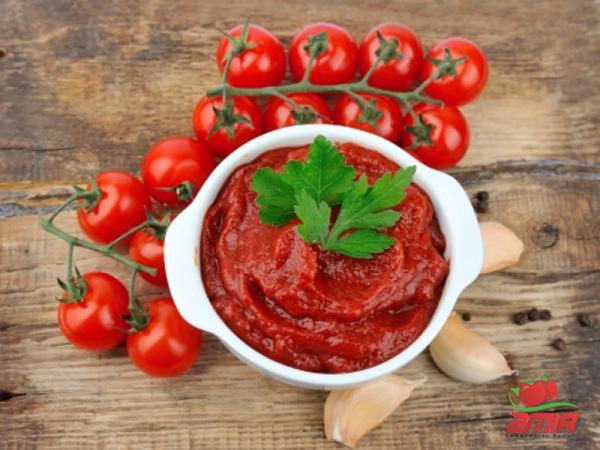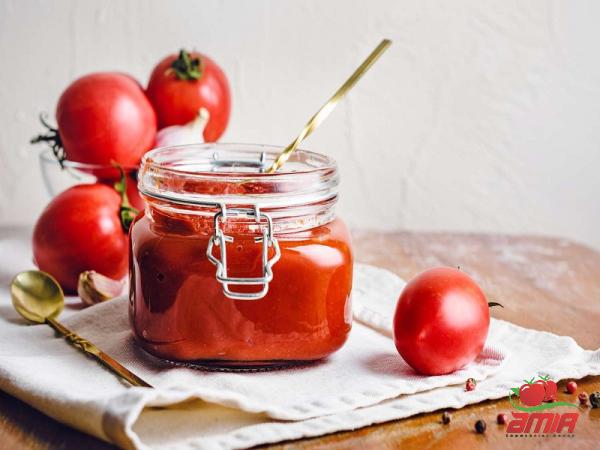Tomato paste is a concentrated form of tomatoes that is widely used in cooking to add flavor, color, and thickness to various dishes. It is made by removing the skin and seeds of ripe tomatoes and cooking them down to remove excess moisture, resulting in a thick, rich paste. Tomato paste is a staple in many cuisines around the world and is commonly used in soups, stews, sauces, and even pizza toppings. Its intense tomato flavor makes it a versatile ingredient that can enhance the taste of various dishes. It is also a convenient ingredient to have on hand, as it has a long shelf life and can be easily incorporated into a variety of recipes. One of the most common forms of packaging for tomato paste is the can. Tomato paste cans are typically made of metal, such as tin or aluminum, and come in various sizes to suit different needs. The cans are sealed to ensure the preservation of the tomato paste and to keep it free from contamination. The canning process starts with the preparation of the tomatoes. Ripe, high-quality tomatoes are selected and washed thoroughly to remove any dirt or impurities. The tomatoes are then blanched—briefly immersed in boiling water—to help remove the skin easily. After blanching, the tomatoes are cooled and peeled manually or mechanically. Once the tomatoes have been peeled, they are crushed to remove the seeds and excess water. The tomato pulp is then cooked down to concentrate the flavors and thicken the paste. The cooking process is important as it helps to deepen the flavor and remove any excess moisture, which contributes to the longer shelf life of the tomato paste. After cooking, the tomato paste is filled into cans. The cans are sterilized to kill any bacteria or microorganisms that may be present. The sterilized cans are then filled with the hot tomato paste and sealed to prevent any air or contaminants from entering. The sealing process is essential to maintain the quality and safety of the tomato paste. Once sealed, the tomato paste cans go through a heat treatment, typically in the form of a retort, to further ensure the safety and shelf life of the product. The retort is a high-pressure vessel that subjects the cans to a combination of steam and pressure, effectively sterilizing the contents. This process helps to kill any remaining bacteria or microorganisms and extends the shelf life of the tomato paste. Tomato paste cans are labeled with important information such as the product name, brand, ingredients, nutritional information, and manufacturing date. This information is required by regulations to provide consumers with transparency and to ensure that they are well-informed about the product they are purchasing. In addition to the traditional metal cans, tomato paste is also available in alternative packaging formats such as tubes or sachets. These formats offer convenience and allow for portion control, as the desired amount of tomato paste can be easily squeezed out and the rest can be stored for later use. In conclusion, tomato paste cans are a popular and convenient packaging format for tomato paste. They provide a longer shelf life, protection from contamination, and easy storage. The canning process ensures the safety and quality of the tomato paste, making it a reliable choice for consumers. Whether used as a base for sauces or as a flavor enhancer in various dishes, tomato paste is a versatile ingredient that adds depth and richness to a wide range of recipes.Title: The Business of Tomato Paste Cans: Manufacturing, Packaging, and Market Insights

tomato paste
 Introduction: The tomato paste industry has witnessed significant growth in recent years, with an increasing demand for canned tomato paste products globally. Tomato paste cans have become a popular packaging format due to their convenience, long shelf life, and ability to preserve the flavor and quality of the product. In this article, we will explore the business aspects of tomato paste cans, including the manufacturing process, packaging considerations, and market insights. 1. Manufacturing Process: The manufacturing process of tomato paste cans involves several key steps. Firstly, high-quality tomatoes are selected and washed to remove any impurities. They are then blanched to facilitate the removal of the skin. After blanching, the tomatoes are peeled, crushed to remove seeds and excess water, and cooked down to concentrate the flavors and thicken the paste. The hot tomato paste is then filled into sterilized cans, sealed, and subjected to heat treatment to ensure product safety and extended shelf life. 2. Packaging Considerations: Tomato paste cans are typically made of metal, such as tin or aluminum, due to their durability and ability to preserve the product’s quality. The cans come in various sizes to cater to different consumer needs. Packaging considerations also include labeling requirements, such as product name, brand, ingredients, nutritional information, and manufacturing date, to comply with regulatory standards and provide transparent information to consumers. 3. Market Trends and Demand: The global market for tomato paste cans is experiencing steady growth, driven by the increasing demand for convenience foods and the rising popularity of international cuisines. Tomato paste cans are widely used in households, restaurants, and fast food chains, making them a staple in the food industry. The market demand can also be attributed to the versatility of tomato paste, as it is an essential ingredient in various cuisines, including Italian, Mexican, and Middle Eastern. 4. Key Players in the Industry: Several key players dominate the tomato paste can industry, including multinational food companies and regional manufacturers. Major players such as Conagra Brands, Inc., Nestlé S.A., and The Kraft Heinz Company have established a strong presence in the market, offering a wide range of tomato paste can products. Regional manufacturers often cater to local markets, providing specialized varieties and flavors to meet specific consumer preferences.
Introduction: The tomato paste industry has witnessed significant growth in recent years, with an increasing demand for canned tomato paste products globally. Tomato paste cans have become a popular packaging format due to their convenience, long shelf life, and ability to preserve the flavor and quality of the product. In this article, we will explore the business aspects of tomato paste cans, including the manufacturing process, packaging considerations, and market insights. 1. Manufacturing Process: The manufacturing process of tomato paste cans involves several key steps. Firstly, high-quality tomatoes are selected and washed to remove any impurities. They are then blanched to facilitate the removal of the skin. After blanching, the tomatoes are peeled, crushed to remove seeds and excess water, and cooked down to concentrate the flavors and thicken the paste. The hot tomato paste is then filled into sterilized cans, sealed, and subjected to heat treatment to ensure product safety and extended shelf life. 2. Packaging Considerations: Tomato paste cans are typically made of metal, such as tin or aluminum, due to their durability and ability to preserve the product’s quality. The cans come in various sizes to cater to different consumer needs. Packaging considerations also include labeling requirements, such as product name, brand, ingredients, nutritional information, and manufacturing date, to comply with regulatory standards and provide transparent information to consumers. 3. Market Trends and Demand: The global market for tomato paste cans is experiencing steady growth, driven by the increasing demand for convenience foods and the rising popularity of international cuisines. Tomato paste cans are widely used in households, restaurants, and fast food chains, making them a staple in the food industry. The market demand can also be attributed to the versatility of tomato paste, as it is an essential ingredient in various cuisines, including Italian, Mexican, and Middle Eastern. 4. Key Players in the Industry: Several key players dominate the tomato paste can industry, including multinational food companies and regional manufacturers. Major players such as Conagra Brands, Inc., Nestlé S.A., and The Kraft Heinz Company have established a strong presence in the market, offering a wide range of tomato paste can products. Regional manufacturers often cater to local markets, providing specialized varieties and flavors to meet specific consumer preferences.
Specifications of tomato paste
 5. Innovations and Product Differentiation: To gain a competitive edge in the tomato paste can market, manufacturers are focusing on product innovations and differentiation. This includes the introduction of organic and non-GMO options, flavor variations, and packaging design enhancements. Some brands may also offer premium or gourmet tomato paste cans, targeting consumers who seek higher quality and unique flavor profiles. 6. Distribution Channels: Tomato paste cans are distributed through multiple channels, including supermarkets, hypermarkets, convenience stores, and online platforms. Retailers play a crucial role in the distribution process and often collaborate with manufacturers to ensure product availability and visibility. Online platforms have also witnessed a surge in tomato paste can sales due to the convenience and ease of ordering for consumers. 7. Export and Import Trends: The global trade of tomato paste cans is a significant aspect of the business. Countries with high tomato production, such as Italy, China, the United States, and Turkey, are major exporters. Import trends vary depending on regional preferences and demand. For example, countries with a strong culinary tradition like Italy or Mexico may import tomato paste cans to meet the demand for authentic flavors and convenience. 8. Quality Control and Safety: Maintaining quality control and ensuring product safety are top priorities in the tomato paste can industry. Manufacturers adhere to strict quality control measures throughout the production process, from sourcing high-quality tomatoes to implementing rigorous hygiene and safety protocols. Regular inspections and testing ensure compliance with food safety standards and regulations.
5. Innovations and Product Differentiation: To gain a competitive edge in the tomato paste can market, manufacturers are focusing on product innovations and differentiation. This includes the introduction of organic and non-GMO options, flavor variations, and packaging design enhancements. Some brands may also offer premium or gourmet tomato paste cans, targeting consumers who seek higher quality and unique flavor profiles. 6. Distribution Channels: Tomato paste cans are distributed through multiple channels, including supermarkets, hypermarkets, convenience stores, and online platforms. Retailers play a crucial role in the distribution process and often collaborate with manufacturers to ensure product availability and visibility. Online platforms have also witnessed a surge in tomato paste can sales due to the convenience and ease of ordering for consumers. 7. Export and Import Trends: The global trade of tomato paste cans is a significant aspect of the business. Countries with high tomato production, such as Italy, China, the United States, and Turkey, are major exporters. Import trends vary depending on regional preferences and demand. For example, countries with a strong culinary tradition like Italy or Mexico may import tomato paste cans to meet the demand for authentic flavors and convenience. 8. Quality Control and Safety: Maintaining quality control and ensuring product safety are top priorities in the tomato paste can industry. Manufacturers adhere to strict quality control measures throughout the production process, from sourcing high-quality tomatoes to implementing rigorous hygiene and safety protocols. Regular inspections and testing ensure compliance with food safety standards and regulations.
buy tomato paste
 9. Sustainability and Eco-Friendly Initiatives: As sustainability becomes an increasingly important consideration in packaging, manufacturers are exploring eco-friendly initiatives for tomato paste cans. This includes using recyclable materials for can production, reducing packaging waste, and implementing energy-efficient manufacturing processes. Brands that prioritize sustainability often resonate with environmentally conscious consumers, providing a competitive advantage in the market. 10. Future Outlook: The future outlook for tomato paste cans remains positive, driven by the increasing demand for convenient and versatile food products. As consumer awareness of the benefits of tomato paste continues to grow, the market is expected to witness steady growth. The industry will likely see further product innovations, packaging enhancements, and a focus on sustainable practices to meet evolving consumer preferences. Conclusion: The business of tomato paste cans is a dynamic and competitive industry. Manufacturers strive to meet consumer demand for convenience, quality, and sustainability while ensuring product safety and compliance with regulations. With the global market for tomato paste cans growing steadily, the industry’s focus on innovations, distribution channels, and market trends will continue to shape its future.
9. Sustainability and Eco-Friendly Initiatives: As sustainability becomes an increasingly important consideration in packaging, manufacturers are exploring eco-friendly initiatives for tomato paste cans. This includes using recyclable materials for can production, reducing packaging waste, and implementing energy-efficient manufacturing processes. Brands that prioritize sustainability often resonate with environmentally conscious consumers, providing a competitive advantage in the market. 10. Future Outlook: The future outlook for tomato paste cans remains positive, driven by the increasing demand for convenient and versatile food products. As consumer awareness of the benefits of tomato paste continues to grow, the market is expected to witness steady growth. The industry will likely see further product innovations, packaging enhancements, and a focus on sustainable practices to meet evolving consumer preferences. Conclusion: The business of tomato paste cans is a dynamic and competitive industry. Manufacturers strive to meet consumer demand for convenience, quality, and sustainability while ensuring product safety and compliance with regulations. With the global market for tomato paste cans growing steadily, the industry’s focus on innovations, distribution channels, and market trends will continue to shape its future.










Your comment submitted.